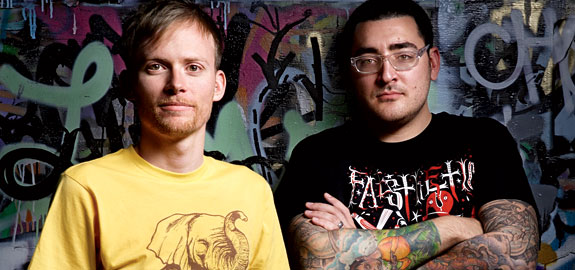
Inspiring Awesomeness – the story of Jake, Jacob and the community that is Threadless
“Threadless was never intended to be a business. When Jacob De Hart and I started out, it was just a hobby, a fun thing to do for the other designers we were friends with.” So says co-founder Jake Nickell in his book on the birth and development of their brand.
The Threadless story begins in 2000 when Jake entered and won a competition on dreamless.org. The competition was to design a t-shirt for a New Media Underground Festival that was being held in London in November that year.
Jake’s winning design was never printed and he didn’t even receive any prize money. However the ‘prize’ he did receive was an idea – he thought “It would be fun to have an on-going competition where people could always submit t-shirt designs, and we would print the best ones”
Jake contacted his friend Jacob, who loved the idea and Threadless was “started about one hour after coming up with the idea” as the two friends posted their first call for entries on the dreamless.org.forum.
They got nearly a 100 entries and decided to pick 5 winners.
 Committing $500 each to cover the cost of printing 24 of each of the 5 designs and the fees of a lawyer to help them incorporate the business, they then built a website through which they would sell the shirts.
Committing $500 each to cover the cost of printing 24 of each of the 5 designs and the fees of a lawyer to help them incorporate the business, they then built a website through which they would sell the shirts.
Keeping things close to home the printing was done by Jacob’s aunt who luckily happened to be a screen printer.
They priced the shirts at $12 and sold out quickly and the boys had their first success and even made some money – 24 x $12 = $1440-$1000 costs = $440 profit!
However any money they made was ploughed back into the business, setting a precedent for their early years. “For the first two years of Threadless, every penny we made from selling tees went into printing more tee designs. We didn’t even take a salary or cut of the sales” says Jake.
Instead, and in keeping with their philosophy, they spent their own time building up a community. The choice of winning tees was changed to customer voting and Jake started posting news of the Threadless contests on any and every design web-site he could find. New batches of t-shirts were at first printed every couple of months, but soon became more and more frequent.
The “hobby”, as Jake and Jacob still held down other web developer jobs for a living, was growing fast and by 2002 the community was 10,000 strong and sales were $100,000.
In 2004 when sales reached $1.5million and new designs were being printed every week, the pair decided to quit their other jobs and concentrate on the brand.
Business boomed growing to $6.5 million but the commitment to the community ethos continued. “Threadless is a community of people first, a t-shirt store second … The best thing we did is to trust our community. To constantly ask them for advice, to show them we are listening, and to change things based on what the community is feeling. We also wholly invest ourselves in being members ourselves” says Jake in the book.
 Even when the pair recruited professional help and Jake gave up the CEO role, he continued as CCO – Chief Community Officer.
Even when the pair recruited professional help and Jake gave up the CEO role, he continued as CCO – Chief Community Officer.
Interviewed by Jay Baer, Jake explained the significance of this on-going commitment and how they strive to maintain it.
“I think that the values that we have that have created the culture here are very important to the success. So now that we’re growing to the size that when new people are brought in, the culture can be very new, it’s just really important to make it clear what Threadless is all about. We have a mission statement to “Inspire Awesomeness” and we have a bunch of internal things that we do to help make sure everyone’s on the same page about it all. We do monthly awesome parties, host DIY days where anyone in the company can basically work on anything, anyone in the company can give anyone else in the company a bonus, etc… There are a ton of things we do!”
So it still sounds like Jake and Jacob’s original intention of it being “a fun thing to do”
And the moral of this story is the best brands don’t focus on the bottom line above all else. What does your brand really focus on?